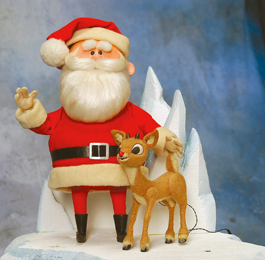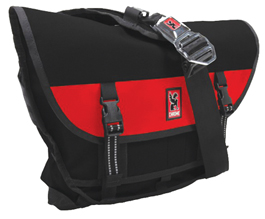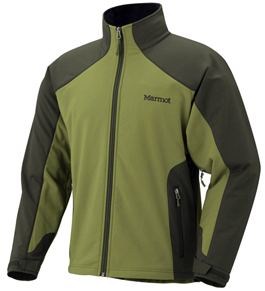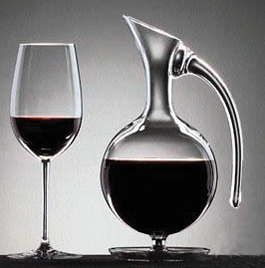home | north bay bohemian index | news | north bay | feature story

YOU COULD EVEN SAY IT GLOWS: The annual resurrection of the claymation oeuvre screams 'holidays' for some of us.
Get Me the Good One
The radically ecological, perversely philosophical, ultimately economical guide to holiday gift-giving
Don't get us wrong—we know the names of the three wise men and all eight reindeer, and we can sing most of "Good King Wenceslas." Also, we are fans of the Rankin-Bass claymation Christmas specials, so please do not bother us with invitations to do less important things on the nights those programs are airing. Because we do love the holidays.
But we've had it up to here—by which we mean way up there—with Christmas waste. Not just the wrapping paper, which is bad enough but can be recycled. No, this is a problem with the holiday gifts themselves, purchased hastily in the weeks leading up to Dec. 25 in a white-knuckle drive to get something, anything, under the tree. This can end in the unfortunate triumph of quantity over quality: we buy multiple second-rate items instead of one good one. And in the nature of second-rate items, these gifts soon break or wear out or just don't get used at all because they're of poor quality to begin with. Within a couple of years, off to the landfill they go to make room for replacements that are just as cheap, just as shoddy, just as surely headed for the trash heap on the same short schedule.
Let's dump that racket now! Here's an idea: buy the good one from the get-go. It costs more up front, but in the long run it saves money, saves the hassle of replacing the item later and is better for the planet. Instead of the $10 headlamp that might last one camping season (but probably won't), spring for the hardy Petzl. Skip the flimsy handmixer and get the aspiring cook the sturdy KitchenAid, the one that would break your foot if it fell off the counter (not that such a thing could ever happen; it weighs far too much to push).
It's a mild-mannered, sociable revolution, and in these pages we're jump-starting it with a list of quality items suited to different age groups that will stand the test of time.—Traci Hukill
Toddler Tales
Ah, the telltale signs of Christmas Eve: the careful placement of milk and cookies for the charitable red trespasser, the hushed tittering of children pretending to sleep, the muffled curses of Santa as he furiously assembles the big-ticket gift—a pink tent or remote-control car or bipedal death machine—before sunrise, only to be completely destroyed by lunchtime, possibly taking one or two good little boys and girls with it. It just wouldn't be Christmas without all these things, would it?
Luckily, Radio Flyer, the wagon and tricycle brand that made memories and destroyed teeth when you were a kid, is still in business and sturdy as ever, and getting easier to assemble all the time. The Radio Flyer #53 Deluxe Steer and Stroll tricycle with co-pilot feature has a great innovation: a backseat driver bar for when your child is still learning to steer—and learning to take direction. Instead of ruining a perfectly cheerful Christmas morning shouting, "Sophie! Not toward the street!" the parent can steer away from danger.
Of course, even the littlest kids tend to grow up over time, despite the promises they made when they were born, and when they're prepared to ride alone, the backseat driver bar can be easily removed. Then with a great swell of pride, you can watch her as she starts to pedal on her own, ready to take on big challenges and responsibilities that you'd never have thought she could. "Sophie! SOPHIE! GET BACK HERE THIS INSTANT!"—Austin Sardella
Pots & Pans
Owner and head chef Michael Gyetvan of Azzurro Pizzeria e Enoteca in Napa used to cook at home with aluminum pans bought from restaurant suppliers, but he noticed that they tended to warp over time. So what does an award-winning chef use in his own residential kitchen? "I'm a pretty firm believer that All-Clad is the way to go," he says, citing the Pennsylvania-made cookware that's been around for four decades. "Obviously, they cost a little bit more, but with the durability, the evenness of cooking—they last a long time." Gyetvan uses restaurant-supply pans at Azzurro, but he's cooked at home with his All-Clad pans for six years now, and they're "excellent."
Like most serious cooks, Gyetvan also swears by the cast-iron skillet. He found his Lodge skillet 15 years ago at a flea market, and it's still a top-quality workhorse. "I use it for anything from fried chicken to cooking steaks," he says. "You can bake in it, you can make macaroni and cheese in it, you can make a stew in it. It's just super versatile." Lodge cookware, still owned by descendants of the original Lodge family, has been made in Tennessee since 1896, and some pans from the turn of the last century are still in use on stovetops throughout the country. "As long as you season it when you first get it and take care of it," Gyetvan says, "it's one of the most versatile and long-lasting pieces of kitchen equipment you could ever own."—Gabe Meline
College Coiffure
A broke college student's options are limited when it comes to good hair. Running around from class to class and subsisting on a steady diet of alcohol and ramen can doom a girl's hair to a life of frizzery. The solution? The Bespoke Labs T3 Featherweight hair dryer. One of the best on the market, this Consumer Reports–approved hair dryer from heaven has the potential to send curly-haired maidens to a utopia where rats' nests cease to exist and split ends are nothing but a myth. This ionic masterpiece contains crushed tourmaline jewels (we wouldn't joke about this) that, when heated, produce negative ions and infrared heat to ensure a speedy blow-dry and shinier, static-free hair. While I'm no chemistry major, I do know that the presence of negative ions will seal the moisture in the hair's cuticle, leaving it ready to brave the elements.
This bad boy may seem a bit pricey, ranging from $80 to $200, but the T3 is sure to last a lot longer than a dinky Conair that will leave the ladies looking like Sideshow Bob. No girl deserves to spend hours styling only to step outside and watch her hair instantly grow like a Chia pet. So when the bells are ringing and the children are singing and the college students are heading home for the holidays, consider giving the student in your life the gift of fabulous, shiny hair worthy of any winter wonderland. It'll blow her mind.—Rula al-Nasrawi

Sling It & Fling It
Every holiday season, my parents take me to buy my annual messenger bag. Not because it's a cherished ritual, but because every time I step off the plane, my mom wrinkles her nose at the ragged shell of the prior year's messenger bag. Most importantly, no real messenger would deign to use my messenger bag.
So I called one—a messenger, that is. "Chrome bags," says Rick Graves from Clutch Couriers without hesitation. "We use them in all weather, riding on a daily basis."
Chrome bags are made from Cordura, a nylon fabric used in military wear, and all Chromes are guaranteed for life. That means even though my Secret Santa will be shelling out somewhere between $80 and $180, I'll never have to go bag shopping with my parents again. Ever.
I'll be asking Santa for the Buran bag ($140), which is technically a laptop bag, a little smaller and trimmer, with ample padding for my computer and a comfy shoulder strap made from seatbelt material. It perfectly skates that fine line between professional and urban. Plus, it avoids the embarrassing issue of sashaying down the street with a half-empty professional messenger bag flopping around on your back in front of real couriers.—Jessica Lussenhop
Turntable Fever
With the release this year of the video game DJ Hero, kids will surely be asking for DJ equipment this Christmas. According to DJ Amen, who along with his weekend radio shows on KMEL 106-FM also plays out in clubs once or twice a week, there's no reason to buy any brand of turntable but Technics 1200s. "There's nothing else that matches up," he says, adding that if your budding turntable king gets tired of cutting and scratching, Technics rigidly retains its resale value. "You could have bought Technics 1200s 10 years ago for $500," he says, "and you could still probably sell a used pair for $350 to $400."
For cartridges, Amen uses Ortofon's DJ Q-bert Concorde cartridge, since it sticks well to the record without skipping, and its needle lasts for years. The top mixer these days is a Rane TTM-57SL, which has the ever-popular Serato Scratch Live software built into it. "It's the industry standard right now," says Amen. "You can control your laptop with the mixer; you don't even have to touch the computer. It's what people like Jazzy Jeff and DJ AM were using, all the way down to people like me." The monitors he and all his friends use are M-Audio BX5A-Ds, and his choice of headphones, which need to be loud and durable, are Technics RPDH 1200s.—G.M.

Very Old Boys
The modern video game geek is faced with three choices when it comes to home consoles: Nintendo Wii ($199), Microsoft Xbox 360 ($199) and Sony Playstation 3 ($299). Each system has its perks; the Wii has the motion sensitive "Nunchuk" controller and the Mario franchise; Xbox 360 has the big online community and the Halo series; and Playstation 3 has the multiple functions and warp-speed processor.
So which system will put more joy in your stick? If it's pure entertainment value you're after, the resounding answer is the Playstation 3. Sure it costs a Benjamin more than the Xbox 360 and the Wii, but that extra cash buys you a Blu-ray player, a wireless internet browser and movie downloader, high definition 1080p output, free online play, 120GB of storage and the ability to also play PS1 and PS2 titles.
The Wii, with its small processor, doesn't approach high-definition output or play even "regular" DVDs. The Xbox 360 boasts a high def gaming output that's nearly as high as the PS3, but you'll have to fork over an extra $100 for an adapter if you want to watch HD DVDs (Blu-ray's all-but-extinct evil twin). And neither system allows you to play old games from its predecessors or browse the internet for free.
When it first dropped in 2006, the newest Playstation's success suffered from a huge $599 price tag and a lack of big-name exclusive games. Today, both issues have been remedied with the price cut in half and titles like Metal Gear Solid 4 and Killzone 2 on shelves, and the long awaited Final Fantasy 13 title coming in a few months.
Holiday cash may be harder than ever to come by, but if your loved one is a gamer who also watches movies, uses the internet or owns an HD television, you'll be doing him or her a favor in the long run by going with the PS3.—Curtis Cartier
Bamboo Bedding
Luxurious sheets are something every woman adores, whether she knows it yet or not. And once she's figured that out, finding the perfect linens can become something of an obsession.
One option, of course, is the classic high-thread count, 100 percent cotton sheet, the kind that's rough and scratchy for a few years until it finally softens and then, decades later, turns into that magnificent texture that's part silk, part suede and all delicious. The problem is, they literally don't seem to be making those anymore. Instead, manufacturers are claiming exorbitant thread counts (500 and 800 are common nowadays) and charging accordingly. But it's fuzzy math—math that counts the piled portions of threads rather than the warp and weft, math that shrinks and pills on the first washing. Consumer Reports busted one maker who claimed a thread count of 1,200; when tallied in the traditional manner, the thread count totaled 416.
Enter the 100 percent viscose sheet set. Made from bamboo, these are smooth, silky sheets that are room temperature rather than cold when you first get in them; they're almost like a very fine flannel in that regard, except that, somehow, they're cool in the summer. And fast-growing bamboo is, of course, the ultimate eco-friendly material. They're not cheap—a 250 thread-count set from Dreamsack will run upward of $200—but they're that elusive combination of high-quality, durable, green and luxurious, and they're guaranteed to make getting that all-important beauty rest a decidedly decadent affair.—T. H.
Plugged-in to Go
Richard Lang, CEO of software company BURST.com, takes a phone call in between multiple meetings. He hesitates for a moment when asked what one good thing he would like to receive as his holiday gift. Then, like the proverbial light bulb suddenly lighting up over his head, the answer clicks. "An electric car," Lang says, "a Tesla sedan." Lang has apparently researched his choice thoroughly, and the reasoning behind it is wide in scope. Zero pollution, 300 miles per electric charge, zero gas usage, 0 to 60 in five and a half seconds. No exhaust. Silent. Seats seven. American-made, locally, in Menlo Park. "Unlike Detroit, Tesla has a 'can-do' attitude of what American cars could be," Lang says, "and they cost less than a small BMW." Add in a nice sound system, and he'll be ready to roll—in 2012, when the first model is ready for market. Lang's preferred color would be a dark green, "like the forests we need to save. It would remind people of why we need to go electric."—Suzanne Daly

Zippy
The soft shell jacket is one of the great inventions of textile science, tailored for winter fun. It's made of the stuff Gore-Tex calls Windstopper. Feather-light, with a texture halfway between neoprene and cashmere, this miracle fabric is windproof, virtually waterproof, breathable and insulates like a wetsuit.
The Marmot Sharp Point Soft Shell runs about $200. It's cut perfectly—it fits snugly, but thanks to its trademarked "Angel-Wing" design, it allows for a remarkable freedom of movement. With a zippered turtleneck collar, velcro wrist-closures and drawstring waist, it battens down completely to keep blowing snow out and body heat in. And pit-zips prevent overheating if your idea of winter fun requires some exertion; as a cross-country ski enthusiast, I appreciate that feature on the uphill runs.
Downhill skiers would probably prefer the Super-Hero, a somewhat warmer and slightly bulkier version of this jacket.
Because the Sharp Point is designed for active wear, it does not work as a winter coat in colder climes. If I'm relaxing after the sun has gone down and the temperature has dropped, I wear it under my tweed coat or motorcycle jacket. I suppose it can also be worn under a hard-shell parka, but I'm old-school.—Eric Johnson
See & Be Seen
Winter weather doesn't stop avid cyclists from tearing up their favorite routes. They just need the right gear, even if that means splurging on a few necessary "good ones." Kim Baenisch, executive director of the Marin County Bike Coalition, puts high-quality, practical accessories on her wish list this year. "A really great headlight and rear blinking light is the kind of thing any cyclist will use, because one of the greatest dangers is being invisible at night," says Baenisch. "But also by law, you need to be riding with a light at night."
With enough LED power to guide Santa's sleigh, the light Baenisch would put on her bike is the Light & Motion Stella ($270, www.coloradocyclist.com). To stay visible and warm during the day, Baenisch recommends the Women's Touring Jacket ($150, www.showerspass.com) in Yelling Yellow, a windproof and waterproof zip-up that will last for seasons to come. "It is sturdy enough to withstand the rain, but also breathable and makes me visible while riding in dark conditions with reflective banding. "It's something I already own," she confesses. "I've had this jacket for a couple years, but I think is a fantastic piece of gear."—Tori Masucci

Flowering from the Stem
I don't care how the rustic peasants in Provence drink their plonk, even if it does look romantic in the movies. I shudder at the very idea of serving an everyday albariņo, much less that special occasion Burgundy, in some cheap, generic wineglass. I want classy Riedel stemware for the ages, made by experts to flatter, enhance and maximize every last drop of precious vino.
Yes, it does matter what size, shape and density of glassware you use. If the bowl of the glass is too small, the wine just doesn't have room to "open," which means in plain English that there's not enough space for oxygen to blend with the wine and magnify the flavors and sensory qualities. And when the whole point is to taste the wine, well, you're essentially defeating the experience.
Also, if the lip of the glass is crude and thick (as in glassware used at bureaucratic lunches), then the wine cannot be guided to the exact point of tongue and palate to deliver the most flavor. Thick glass insults both the drink and the drinker.
If the glassware is chunky, the experience is chunky. Every Riedel glass is carefully designed with ample room for flavor expansion and to deliver specific varietals to their intended taste bud. Riedel makes crystal glasses for every wine varietal, with 24 percent lead content crystal to guarantee color-heightening clarity.
A great wine deserves a great glass. And a decent wine will sip much better than it otherwise would when poured into a great glass. That's why I want Riedel. Worried about breakage? At $30 a glass, one tends to be careful.—Christina Waters
Someone to Love
Sonoma State University's Stevenson Hall is covered in old ivy, its vines now crawling over more of its north face than back when President Ruben Armiņana took office in 1992. As the last of autumn's red and gold leaves fell outside of his window, Armiņana took a few days away from his Stevenson office to recover from surgery. His "good one" is a humble reminder that man's best friend can offer comfort and companionship for years to come. "We lost a dog two months ago, and the one I have now, a flat-coat retriever, is a bit bored by himself. I am looking for another purebred, but from a rescue place as I did with my present dog, Hubert. This way, I get the best of two opportunities—a purebred dog and rescue one. That's my wish."—T.M.
An Apple a Decade
Get 'em a Mac! Yes, you'll have to spend more upfront. And no, you might not find a dirty little third-party app that converts the icons in ChickenEyeball TurboXtreem into Windows Media movies.
But by shelling out more for a Macintosh computer than for a PC, you'll give your giftee a computer that will work, and last, for years. Let's talk tech: Macs have firewalls already built in, don't attract every virus, worm and Trojan horse ever born, and come with free security updates that automatically appear, download at the click of a button and virtually self-install.
In addition, Macs feature decent operating systems built upward, in English, from their core. Each OS is built on the last, so unless you want the newest and grooviest, updating is optional. And when you do update, you'll find that each new version is actually better, rather than less bad, with most features right in the same familiar places, but working even faster and more easily.
And if a Mac ever does crash, which is rare, you won't go through sudden collapses into low-budget '60s sci-fi-style black screens filled with gibberish, or urgent demands that you move 350 files—all named jibble.kibble—from drive B to drive C before everything goes to hell. Macs have one drive, and it doesn't care where things are. If you've got an app, you can use it.
Finally, there are the positives Macs are famous for; namely, their ability to help those with graphic and artistic talent. Duplicating files perfectly in their native format takes just one key combo. Copying, pasting, importing, exporting, zooming, minimizing and converting are all a cinch. And the colors and rendering are gorgeous. That's why nearly every film studio and graphics shop in the United States uses Macs. We say, give your loved one the same quality.—Paul Wagner
Sound Waves
Hoytus Rolen always greets customers at People's Music in Sebastopol with a big smile. With graying dread locks captured by his signature colorful woven cap and heavy ethnic jewelry of silver and beads, Rolen exudes a natural warmth. His calm demeanor serves him well when dealing with customers or his young music students. When asked what Santa might bring him if he wanted just one good item, the shaggy musician answers without hesitation. "I'd like a Bose Wave music system (about $500). I wouldn't need another system for the rest of my life, and I could listen to anything better than I've ever heard it." Another friend enters the shop—and the conversation. Maceo Campbell, a musician with the Peace Warriors whose giant laugh mirrors his ample physique, chimes in. "You've got to have a subwoofer, too. When you add the subwoofer, you're going to be in heaven!" Rolen nods, and adds that although the system can be moved anywhere, he would most likely listen to it in his studio, and never come out. "Except to pee!" Maceo shouts, to laughs all around.—S.D.
Put Your Lips Together and . . .
Charlie Musselwhite shudders at the thought of cheaply made harmonicas given as stocking stuffers. "I only use Seydel harmonicas," says the 23-time W.C. Handy Award–winning bluesman. "The Seydel company is even older than Hohner, and they still make them by hand, one at a time, in a little town in Germany. Hohners are now mass-produced in China. The Seydel people make a wide variety of harps, and the ones I use have stainless steel reeds. They can be initially costly, but when you realize that one Seydel will outlast a dozen other brands, you're actually saving money. The only better harmonica would be a custom-made harmonica, and I think Seydels are as good and often better than some custom harps I've played."
Harmonicas aren't the only thing on Musselwhite's mind this Christmas. "The other gift I'd like to mention is I once saw a flying alarm clock for people who just turn the alarm off and go back to sleep," he says. "The clock has a propeller like a helicopter, and when the alarm goes off, it sounds like a helicopter, it lifts off and flies around the room and you have to get up, chase it, catch it and put it back in the clock base to turn it off. Well, by then you are definitely up and out of bed and not going back to sleep."—G.M.
San Francisco.com Real Estate
Moving to the Bay Area just became easy. Let San Francisco.com show you all the homes currently for sale.
San Jose.com Real Estate
Relocating to San Jose or Silicon Valley? Let San Jose.com introduce you to some expert area real estate agents.
Not Too Much to Ask
Pt. Reyes Station's Bovine Bakery smells heavenly the moment you enter, and the mouthwatering sights match the scents. Behind the counter, longtime owner Bridget Devlin looks perplexed as she ponders what her one good gift might be. She asks the question of the other women working the dough in the back. Tugging at one of her blond, shoulder-length braids, brows furrowed over her bright blue eyes, she sighs. "I don't really want much of anything." Rethinking her statement, she comes up with the idea of an original piece of art, refining her request to "an original Alexander Calder hanging mobile, in bright, primary colors." It would hang aloft in her high-ceilinged bedroom, moving with the air currents. Co-worker Elsie Riley has no problem figuring out what she would want. "Just give me $5,000 a month for the rest of my life," she smiles. "I would be quite happy with that."—S.D.
Send a letter to the editor about this story.
|
|
|
|
|
|
